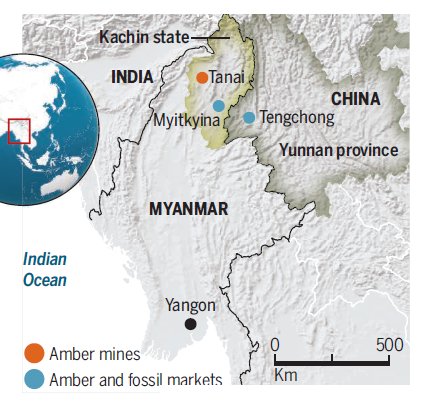Ever since prehistoric times amber has been treasured as a rare and beautiful gemstone that we know was used in some of the earliest pieces of jewelry ever made. Amber isn’t actually a stone however; it’s just fossilized tree sap. That is, sap that has dripped down the side of a tree, dried out and become petrified over thousands or more likely millions of years.
Sometimes that tree sap can even capture a small living creature within it before it becomes hard, insects and spiders are the most common victims. And as the sap fossilizes the animal with it can be exquisitely preserved creating some of the best specimens of ancient life known to paleontology. This preservation in amber was even the main plot device in the ‘Jurassic Park’ movies where scientists obtain dino DNA from mosquitoes that have been preserved in amber.

So it’s hardly surprising that paleontologists are always searching for new sources of amber that could contain unknown species from the past. In recent years the best, most interesting fossil amber has come from mines in the province of Kachin in the northeast of the country of Myanmar, formerly known as Burma. See map below.

I have already written a post about one of the most interesting finds discovered in Burmese amber, the tail of a very small dinosaur, with feathers on it. See my post of 16 December 2016 and the image below. Certainly the odds of something so rare happening must be enormous but given millions of years of past history even something that seems next to impossible will eventually occur.

The same could be said for a more recent find, the shell of an extinct sea creature known as an ammonite. See image below.

How could the shell of a creature of the ocean ever get trapped inside the sap from a land tree? Well one clue is that it is only the shell of the animal, all of the soft tissue had decayed before it was encased. Probably the shell was washed up on the shore, perhaps during a storm so that the waves could have could have pushed it fairly far inland, far enough to wind up at the base of a tree that was dripping sap. A one in a billion chance that; again if you wait long enough will happen.
Fossils in amber are also known from other sites around the world such as the Baltic or the Dominican Republic but the amber from Myanmar is both older and for some reason not yet understood, the sap occasionally seems to have trapped larger, stronger, more active creatures such as snakes, lizards and even a few birds. Because of these factors paleontologists are rushing to acquire as much of the Burmese amber as they can.

There is blood on the amber coming from Myanmar however, for the province of Kachin is a conflict zone and the amber mines are controlled by rebels who call themselves the Kachin Independence Army and who are fighting the central government. The situation in Myanmar is very similar to that of the blood-diamonds from Africa in the 1990s where militant insurgents would exploit natural resources in the regions they control in order to fund their rebel armies.

The same is now happening to the Burmese amber, which is smuggled into nearby China and sold in the markets of cities like Tengchong in Yunnan province. It’s there that paleontologists have to search in order to obtain the scientifically important specimens before they are sold to someone interested only in amber for jewelry.

In fact no paleontologist or geologist has ever been able to visit one of the amber mines in order to actually determine the precise age of the strata from which the amber comes. Present estimates of 99 million year old are based upon the study of the animals found in the amber and many scientists feel that the amber really has a range of dates.
Obviously this is not a good way to do science. A lot of information about the animal encased in the amber is lost when proper records are not kept. Paleontology is about more than just discovering and describing extinct lifeforms; it’s also about understanding the conditions in which they lived and with what other creatures. All that data is lost when a specimen is smuggled out of a war zone into another country and sold in an open market.
In the years to come I have no doubt that many more fascinating creatures from the age of the dinosaurs will be found in the Burmese amber. How much more could we learn however if scientists could obtain access to the source of the amber and do a proper job of excavation?
